Ethics Essay: Analysis of Skinner v. Railway Labor Executives' Case
VerifiedAdded on 2023/03/20
|8
|2053
|69
Essay
AI Summary
This essay provides an in-depth analysis of the ethical dimensions of the Supreme Court case Skinner v. Railway Labor Executives', focusing on the conflict between legal and moral obligations within a business context. The paper examines the case through a deontological lens, particularly drawing on the ethical framework of Immanuel Kant to assess the morality of the court's holding regarding employee drug testing. It explores the tension between employee privacy rights and the employer's responsibility to ensure safety, especially in the railway industry. The essay discusses the intentions of both employers and employees, considering whether the actions align with ethical principles and the implications of the court's decision on workplace practices. The analysis also touches upon the thin line between what is legally permissible and morally right, and how these concepts may or may not coincide, concluding that the court's decision was morally sound. The essay utilizes references to scholarly work and legal sources to support its arguments.
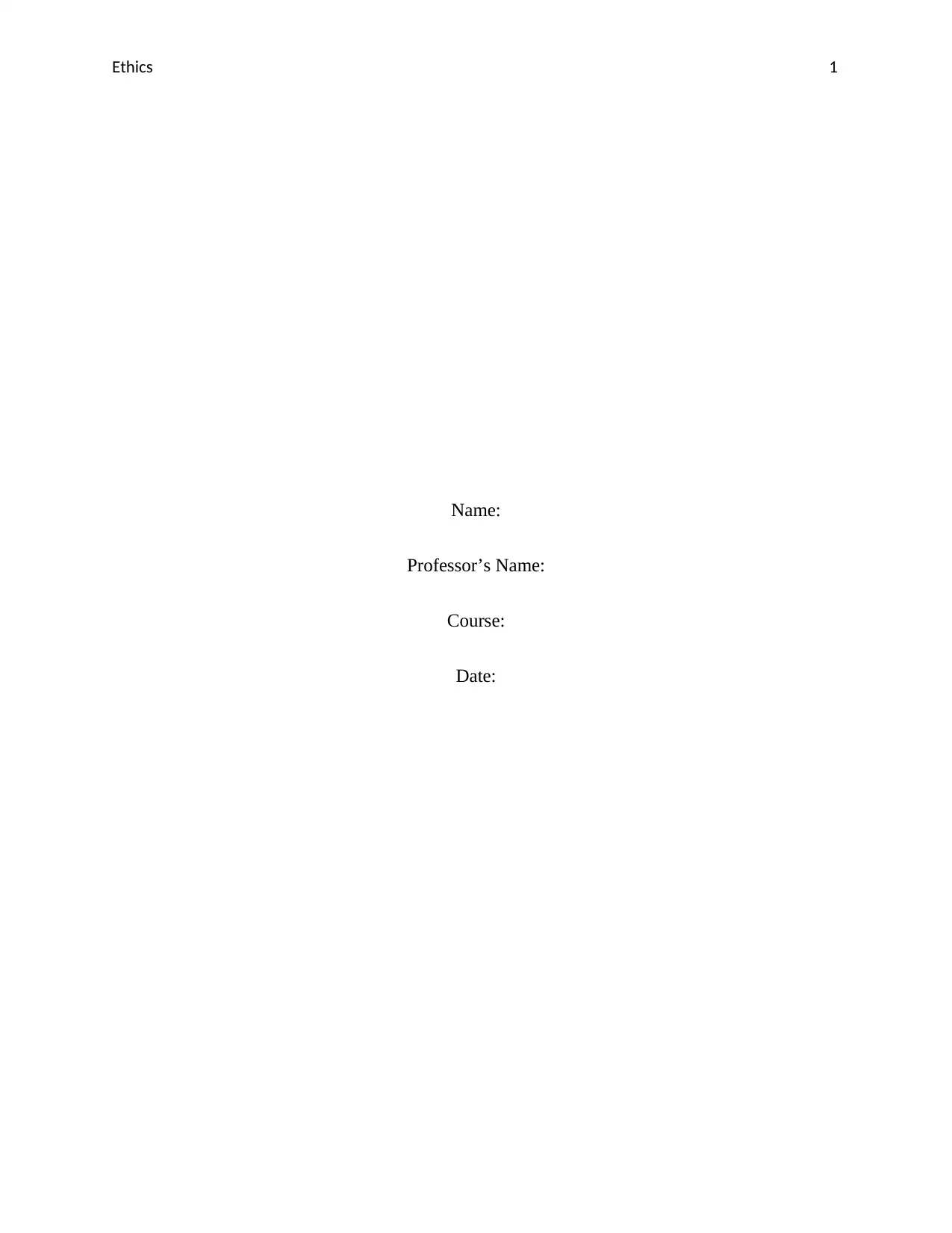
Ethics 1
Name:
Professor’s Name:
Course:
Date:
Name:
Professor’s Name:
Course:
Date:
Paraphrase This Document
Need a fresh take? Get an instant paraphrase of this document with our AI Paraphraser
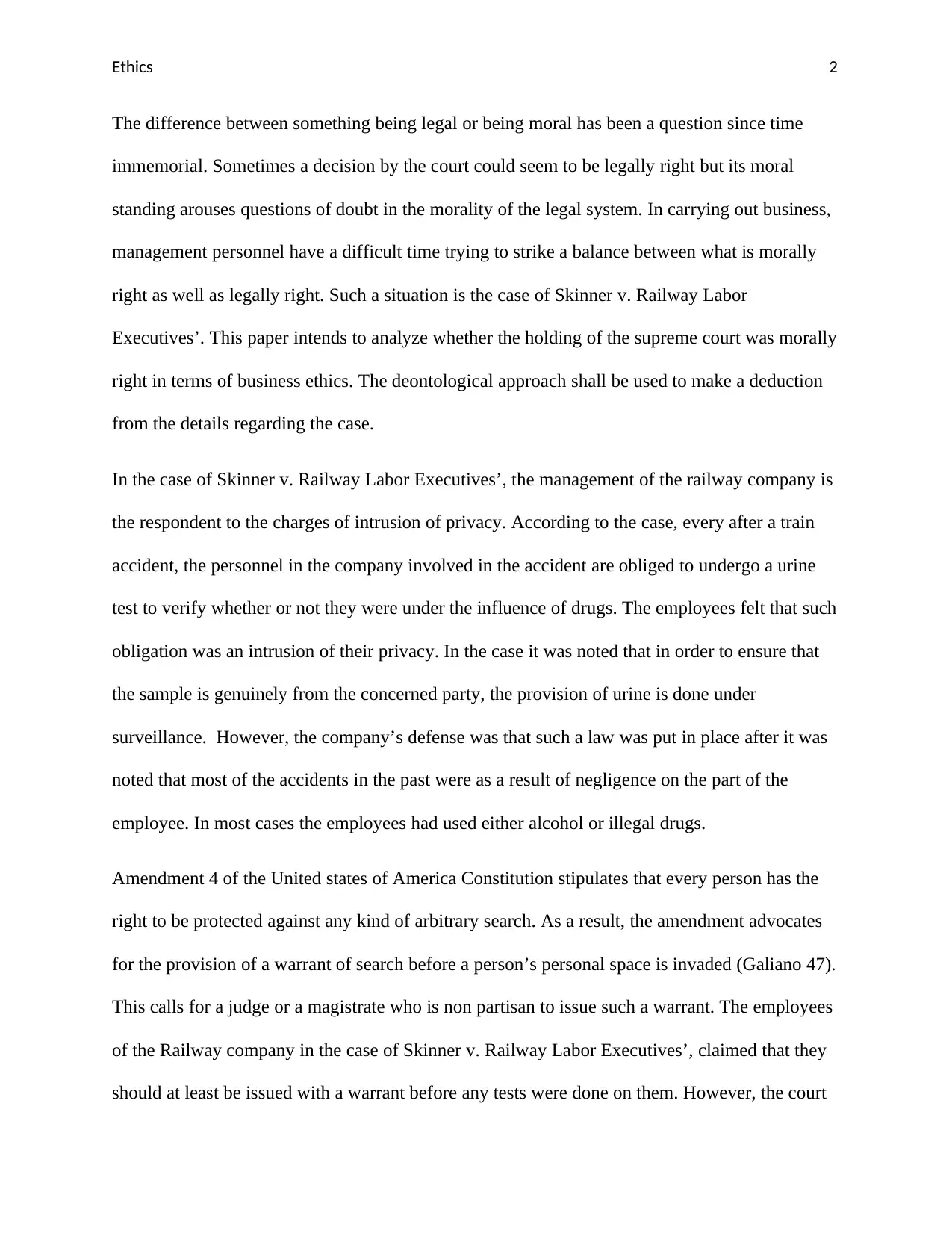
Ethics 2
The difference between something being legal or being moral has been a question since time
immemorial. Sometimes a decision by the court could seem to be legally right but its moral
standing arouses questions of doubt in the morality of the legal system. In carrying out business,
management personnel have a difficult time trying to strike a balance between what is morally
right as well as legally right. Such a situation is the case of Skinner v. Railway Labor
Executives’. This paper intends to analyze whether the holding of the supreme court was morally
right in terms of business ethics. The deontological approach shall be used to make a deduction
from the details regarding the case.
In the case of Skinner v. Railway Labor Executives’, the management of the railway company is
the respondent to the charges of intrusion of privacy. According to the case, every after a train
accident, the personnel in the company involved in the accident are obliged to undergo a urine
test to verify whether or not they were under the influence of drugs. The employees felt that such
obligation was an intrusion of their privacy. In the case it was noted that in order to ensure that
the sample is genuinely from the concerned party, the provision of urine is done under
surveillance. However, the company’s defense was that such a law was put in place after it was
noted that most of the accidents in the past were as a result of negligence on the part of the
employee. In most cases the employees had used either alcohol or illegal drugs.
Amendment 4 of the United states of America Constitution stipulates that every person has the
right to be protected against any kind of arbitrary search. As a result, the amendment advocates
for the provision of a warrant of search before a person’s personal space is invaded (Galiano 47).
This calls for a judge or a magistrate who is non partisan to issue such a warrant. The employees
of the Railway company in the case of Skinner v. Railway Labor Executives’, claimed that they
should at least be issued with a warrant before any tests were done on them. However, the court
The difference between something being legal or being moral has been a question since time
immemorial. Sometimes a decision by the court could seem to be legally right but its moral
standing arouses questions of doubt in the morality of the legal system. In carrying out business,
management personnel have a difficult time trying to strike a balance between what is morally
right as well as legally right. Such a situation is the case of Skinner v. Railway Labor
Executives’. This paper intends to analyze whether the holding of the supreme court was morally
right in terms of business ethics. The deontological approach shall be used to make a deduction
from the details regarding the case.
In the case of Skinner v. Railway Labor Executives’, the management of the railway company is
the respondent to the charges of intrusion of privacy. According to the case, every after a train
accident, the personnel in the company involved in the accident are obliged to undergo a urine
test to verify whether or not they were under the influence of drugs. The employees felt that such
obligation was an intrusion of their privacy. In the case it was noted that in order to ensure that
the sample is genuinely from the concerned party, the provision of urine is done under
surveillance. However, the company’s defense was that such a law was put in place after it was
noted that most of the accidents in the past were as a result of negligence on the part of the
employee. In most cases the employees had used either alcohol or illegal drugs.
Amendment 4 of the United states of America Constitution stipulates that every person has the
right to be protected against any kind of arbitrary search. As a result, the amendment advocates
for the provision of a warrant of search before a person’s personal space is invaded (Galiano 47).
This calls for a judge or a magistrate who is non partisan to issue such a warrant. The employees
of the Railway company in the case of Skinner v. Railway Labor Executives’, claimed that they
should at least be issued with a warrant before any tests were done on them. However, the court
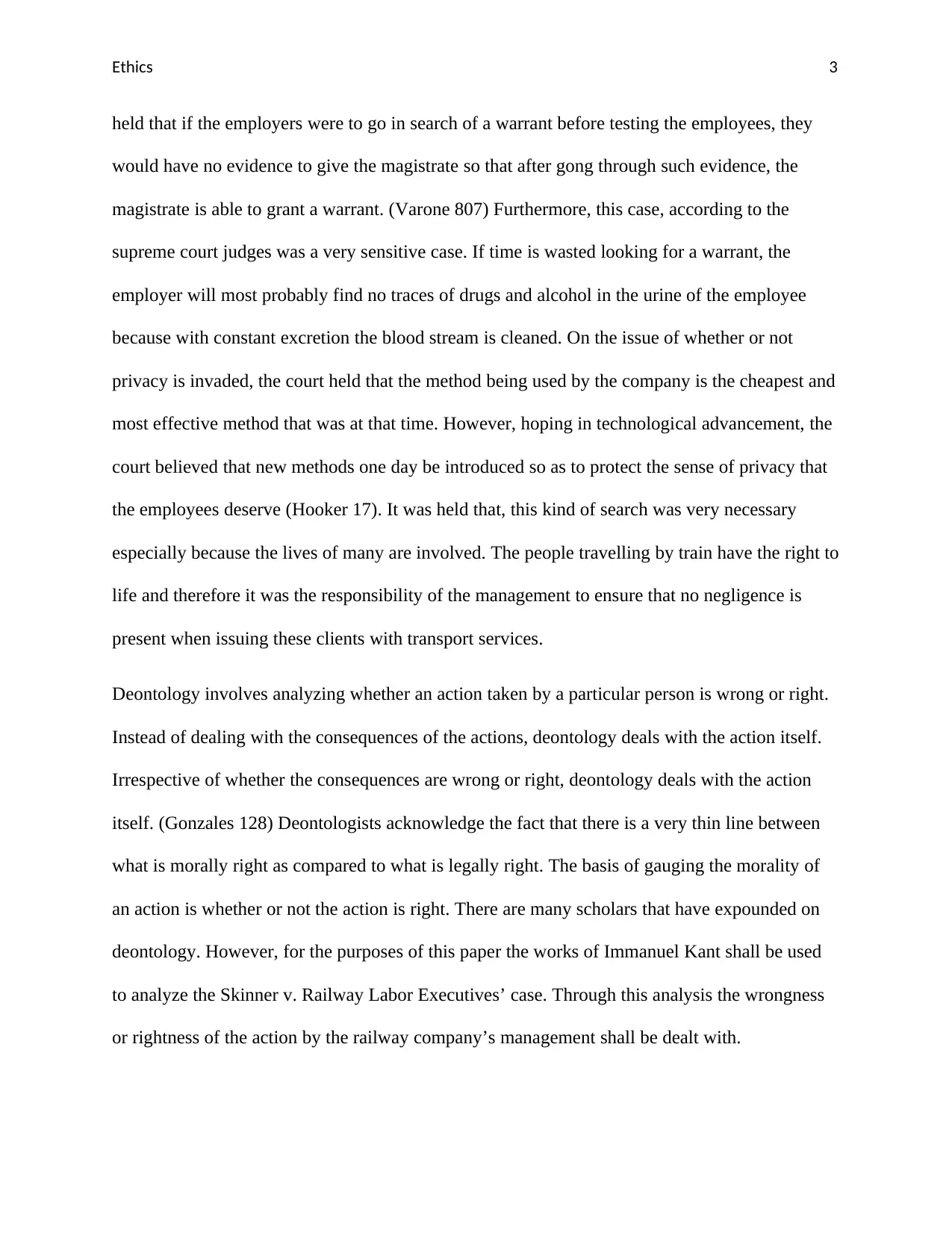
Ethics 3
held that if the employers were to go in search of a warrant before testing the employees, they
would have no evidence to give the magistrate so that after gong through such evidence, the
magistrate is able to grant a warrant. (Varone 807) Furthermore, this case, according to the
supreme court judges was a very sensitive case. If time is wasted looking for a warrant, the
employer will most probably find no traces of drugs and alcohol in the urine of the employee
because with constant excretion the blood stream is cleaned. On the issue of whether or not
privacy is invaded, the court held that the method being used by the company is the cheapest and
most effective method that was at that time. However, hoping in technological advancement, the
court believed that new methods one day be introduced so as to protect the sense of privacy that
the employees deserve (Hooker 17). It was held that, this kind of search was very necessary
especially because the lives of many are involved. The people travelling by train have the right to
life and therefore it was the responsibility of the management to ensure that no negligence is
present when issuing these clients with transport services.
Deontology involves analyzing whether an action taken by a particular person is wrong or right.
Instead of dealing with the consequences of the actions, deontology deals with the action itself.
Irrespective of whether the consequences are wrong or right, deontology deals with the action
itself. (Gonzales 128) Deontologists acknowledge the fact that there is a very thin line between
what is morally right as compared to what is legally right. The basis of gauging the morality of
an action is whether or not the action is right. There are many scholars that have expounded on
deontology. However, for the purposes of this paper the works of Immanuel Kant shall be used
to analyze the Skinner v. Railway Labor Executives’ case. Through this analysis the wrongness
or rightness of the action by the railway company’s management shall be dealt with.
held that if the employers were to go in search of a warrant before testing the employees, they
would have no evidence to give the magistrate so that after gong through such evidence, the
magistrate is able to grant a warrant. (Varone 807) Furthermore, this case, according to the
supreme court judges was a very sensitive case. If time is wasted looking for a warrant, the
employer will most probably find no traces of drugs and alcohol in the urine of the employee
because with constant excretion the blood stream is cleaned. On the issue of whether or not
privacy is invaded, the court held that the method being used by the company is the cheapest and
most effective method that was at that time. However, hoping in technological advancement, the
court believed that new methods one day be introduced so as to protect the sense of privacy that
the employees deserve (Hooker 17). It was held that, this kind of search was very necessary
especially because the lives of many are involved. The people travelling by train have the right to
life and therefore it was the responsibility of the management to ensure that no negligence is
present when issuing these clients with transport services.
Deontology involves analyzing whether an action taken by a particular person is wrong or right.
Instead of dealing with the consequences of the actions, deontology deals with the action itself.
Irrespective of whether the consequences are wrong or right, deontology deals with the action
itself. (Gonzales 128) Deontologists acknowledge the fact that there is a very thin line between
what is morally right as compared to what is legally right. The basis of gauging the morality of
an action is whether or not the action is right. There are many scholars that have expounded on
deontology. However, for the purposes of this paper the works of Immanuel Kant shall be used
to analyze the Skinner v. Railway Labor Executives’ case. Through this analysis the wrongness
or rightness of the action by the railway company’s management shall be dealt with.
⊘ This is a preview!⊘
Do you want full access?
Subscribe today to unlock all pages.

Trusted by 1+ million students worldwide
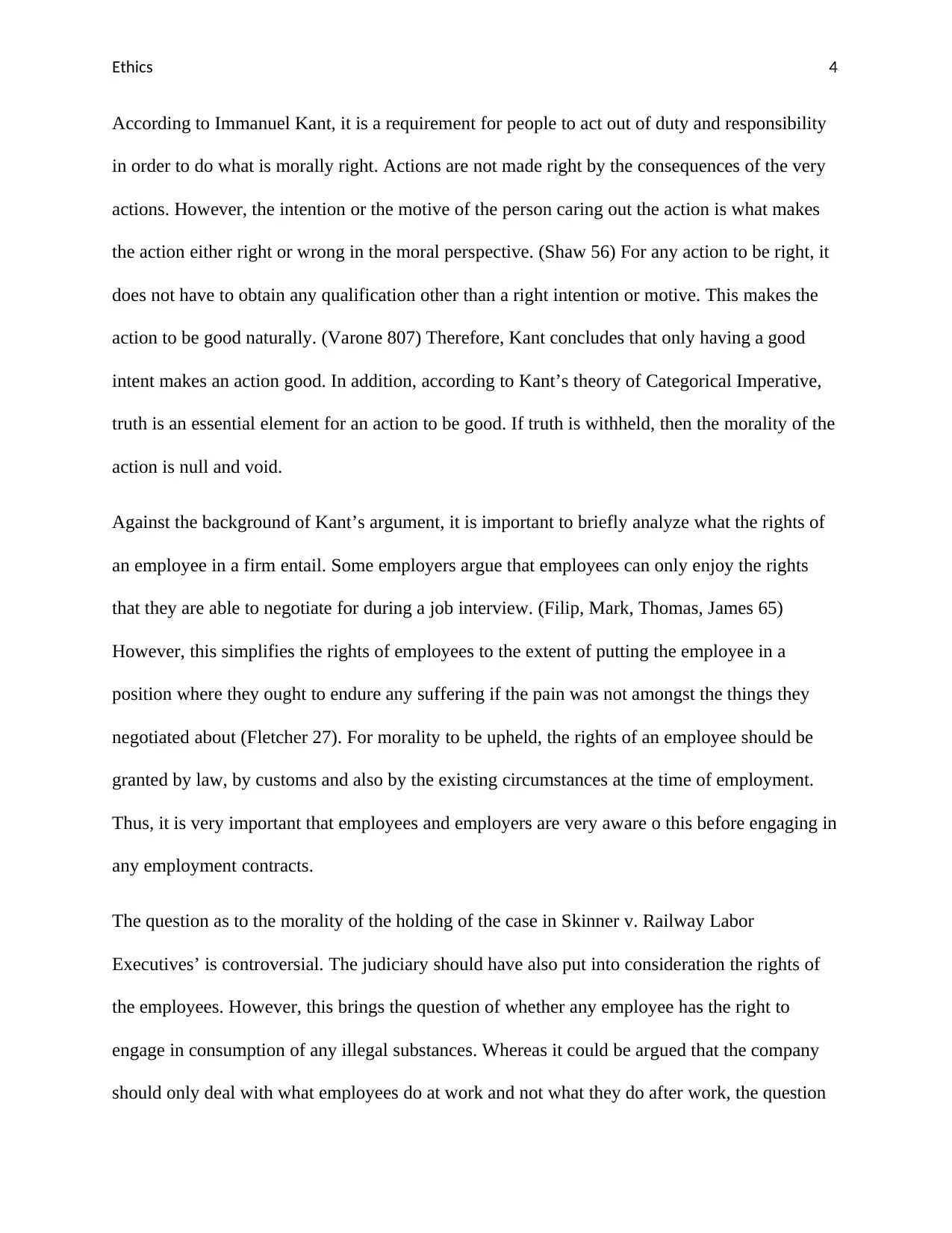
Ethics 4
According to Immanuel Kant, it is a requirement for people to act out of duty and responsibility
in order to do what is morally right. Actions are not made right by the consequences of the very
actions. However, the intention or the motive of the person caring out the action is what makes
the action either right or wrong in the moral perspective. (Shaw 56) For any action to be right, it
does not have to obtain any qualification other than a right intention or motive. This makes the
action to be good naturally. (Varone 807) Therefore, Kant concludes that only having a good
intent makes an action good. In addition, according to Kant’s theory of Categorical Imperative,
truth is an essential element for an action to be good. If truth is withheld, then the morality of the
action is null and void.
Against the background of Kant’s argument, it is important to briefly analyze what the rights of
an employee in a firm entail. Some employers argue that employees can only enjoy the rights
that they are able to negotiate for during a job interview. (Filip, Mark, Thomas, James 65)
However, this simplifies the rights of employees to the extent of putting the employee in a
position where they ought to endure any suffering if the pain was not amongst the things they
negotiated about (Fletcher 27). For morality to be upheld, the rights of an employee should be
granted by law, by customs and also by the existing circumstances at the time of employment.
Thus, it is very important that employees and employers are very aware o this before engaging in
any employment contracts.
The question as to the morality of the holding of the case in Skinner v. Railway Labor
Executives’ is controversial. The judiciary should have also put into consideration the rights of
the employees. However, this brings the question of whether any employee has the right to
engage in consumption of any illegal substances. Whereas it could be argued that the company
should only deal with what employees do at work and not what they do after work, the question
According to Immanuel Kant, it is a requirement for people to act out of duty and responsibility
in order to do what is morally right. Actions are not made right by the consequences of the very
actions. However, the intention or the motive of the person caring out the action is what makes
the action either right or wrong in the moral perspective. (Shaw 56) For any action to be right, it
does not have to obtain any qualification other than a right intention or motive. This makes the
action to be good naturally. (Varone 807) Therefore, Kant concludes that only having a good
intent makes an action good. In addition, according to Kant’s theory of Categorical Imperative,
truth is an essential element for an action to be good. If truth is withheld, then the morality of the
action is null and void.
Against the background of Kant’s argument, it is important to briefly analyze what the rights of
an employee in a firm entail. Some employers argue that employees can only enjoy the rights
that they are able to negotiate for during a job interview. (Filip, Mark, Thomas, James 65)
However, this simplifies the rights of employees to the extent of putting the employee in a
position where they ought to endure any suffering if the pain was not amongst the things they
negotiated about (Fletcher 27). For morality to be upheld, the rights of an employee should be
granted by law, by customs and also by the existing circumstances at the time of employment.
Thus, it is very important that employees and employers are very aware o this before engaging in
any employment contracts.
The question as to the morality of the holding of the case in Skinner v. Railway Labor
Executives’ is controversial. The judiciary should have also put into consideration the rights of
the employees. However, this brings the question of whether any employee has the right to
engage in consumption of any illegal substances. Whereas it could be argued that the company
should only deal with what employees do at work and not what they do after work, the question
Paraphrase This Document
Need a fresh take? Get an instant paraphrase of this document with our AI Paraphraser
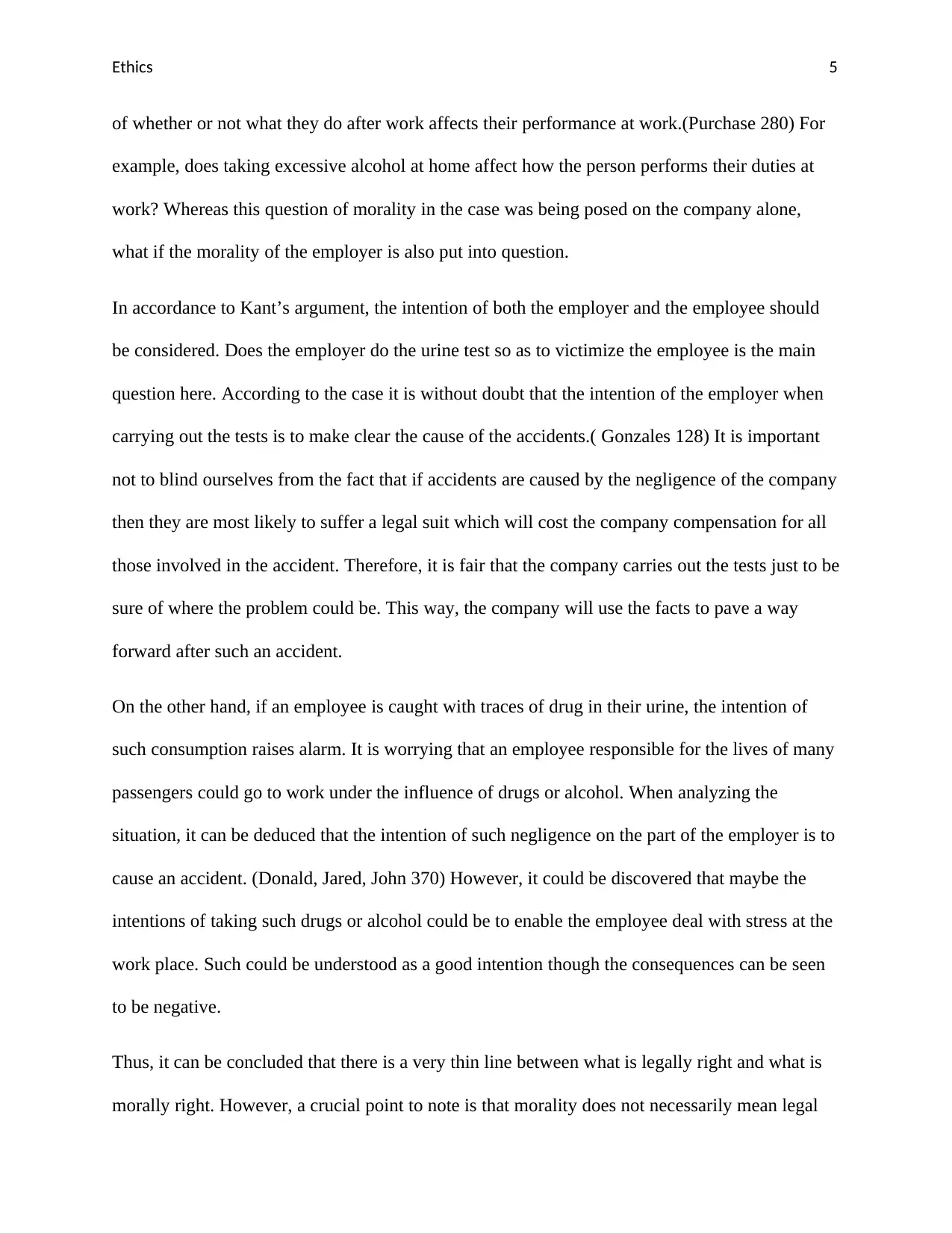
Ethics 5
of whether or not what they do after work affects their performance at work.(Purchase 280) For
example, does taking excessive alcohol at home affect how the person performs their duties at
work? Whereas this question of morality in the case was being posed on the company alone,
what if the morality of the employer is also put into question.
In accordance to Kant’s argument, the intention of both the employer and the employee should
be considered. Does the employer do the urine test so as to victimize the employee is the main
question here. According to the case it is without doubt that the intention of the employer when
carrying out the tests is to make clear the cause of the accidents.( Gonzales 128) It is important
not to blind ourselves from the fact that if accidents are caused by the negligence of the company
then they are most likely to suffer a legal suit which will cost the company compensation for all
those involved in the accident. Therefore, it is fair that the company carries out the tests just to be
sure of where the problem could be. This way, the company will use the facts to pave a way
forward after such an accident.
On the other hand, if an employee is caught with traces of drug in their urine, the intention of
such consumption raises alarm. It is worrying that an employee responsible for the lives of many
passengers could go to work under the influence of drugs or alcohol. When analyzing the
situation, it can be deduced that the intention of such negligence on the part of the employer is to
cause an accident. (Donald, Jared, John 370) However, it could be discovered that maybe the
intentions of taking such drugs or alcohol could be to enable the employee deal with stress at the
work place. Such could be understood as a good intention though the consequences can be seen
to be negative.
Thus, it can be concluded that there is a very thin line between what is legally right and what is
morally right. However, a crucial point to note is that morality does not necessarily mean legal
of whether or not what they do after work affects their performance at work.(Purchase 280) For
example, does taking excessive alcohol at home affect how the person performs their duties at
work? Whereas this question of morality in the case was being posed on the company alone,
what if the morality of the employer is also put into question.
In accordance to Kant’s argument, the intention of both the employer and the employee should
be considered. Does the employer do the urine test so as to victimize the employee is the main
question here. According to the case it is without doubt that the intention of the employer when
carrying out the tests is to make clear the cause of the accidents.( Gonzales 128) It is important
not to blind ourselves from the fact that if accidents are caused by the negligence of the company
then they are most likely to suffer a legal suit which will cost the company compensation for all
those involved in the accident. Therefore, it is fair that the company carries out the tests just to be
sure of where the problem could be. This way, the company will use the facts to pave a way
forward after such an accident.
On the other hand, if an employee is caught with traces of drug in their urine, the intention of
such consumption raises alarm. It is worrying that an employee responsible for the lives of many
passengers could go to work under the influence of drugs or alcohol. When analyzing the
situation, it can be deduced that the intention of such negligence on the part of the employer is to
cause an accident. (Donald, Jared, John 370) However, it could be discovered that maybe the
intentions of taking such drugs or alcohol could be to enable the employee deal with stress at the
work place. Such could be understood as a good intention though the consequences can be seen
to be negative.
Thus, it can be concluded that there is a very thin line between what is legally right and what is
morally right. However, a crucial point to note is that morality does not necessarily mean legal
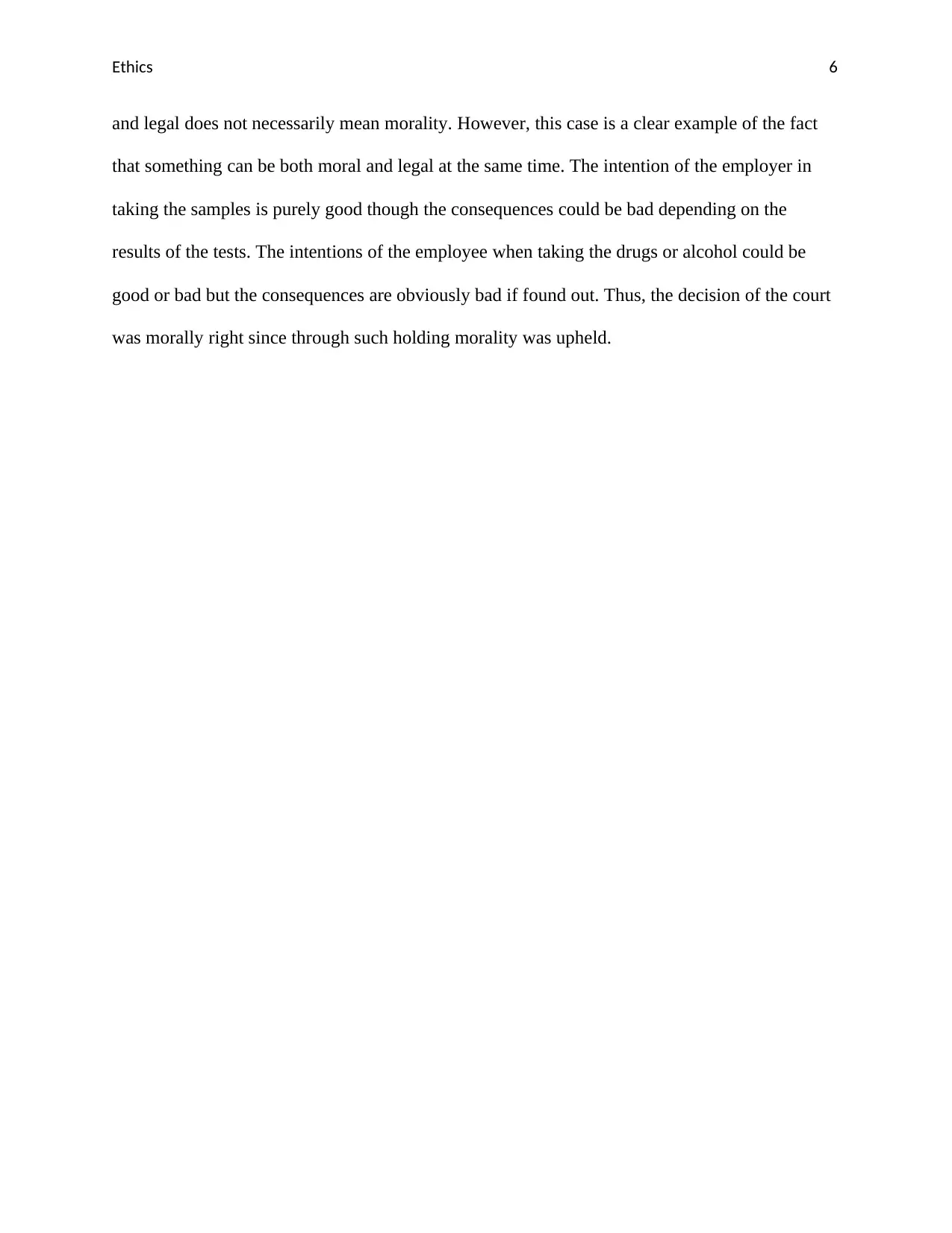
Ethics 6
and legal does not necessarily mean morality. However, this case is a clear example of the fact
that something can be both moral and legal at the same time. The intention of the employer in
taking the samples is purely good though the consequences could be bad depending on the
results of the tests. The intentions of the employee when taking the drugs or alcohol could be
good or bad but the consequences are obviously bad if found out. Thus, the decision of the court
was morally right since through such holding morality was upheld.
and legal does not necessarily mean morality. However, this case is a clear example of the fact
that something can be both moral and legal at the same time. The intention of the employer in
taking the samples is purely good though the consequences could be bad depending on the
results of the tests. The intentions of the employee when taking the drugs or alcohol could be
good or bad but the consequences are obviously bad if found out. Thus, the decision of the court
was morally right since through such holding morality was upheld.
⊘ This is a preview!⊘
Do you want full access?
Subscribe today to unlock all pages.

Trusted by 1+ million students worldwide
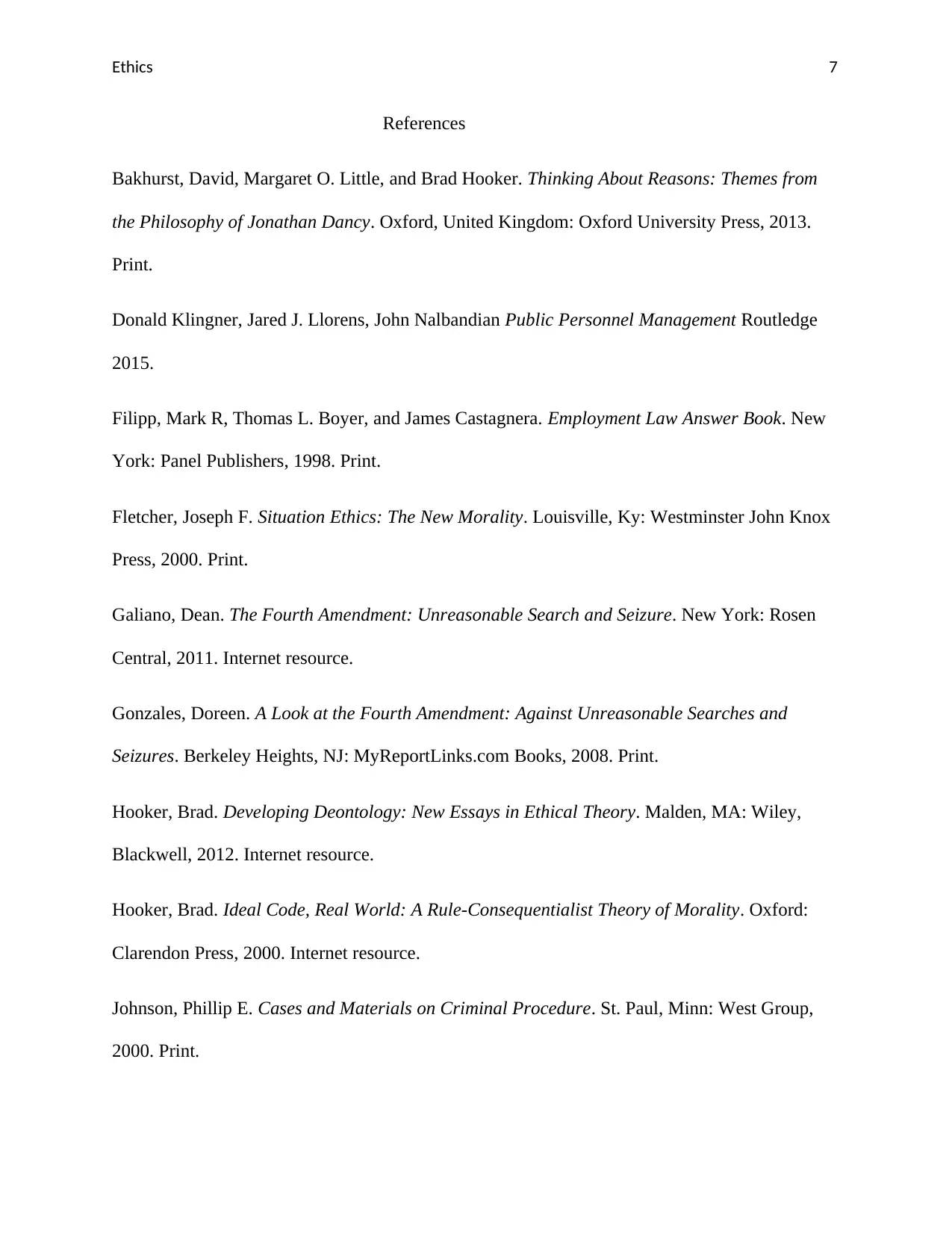
Ethics 7
References
Bakhurst, David, Margaret O. Little, and Brad Hooker. Thinking About Reasons: Themes from
the Philosophy of Jonathan Dancy. Oxford, United Kingdom: Oxford University Press, 2013.
Print.
Donald Klingner, Jared J. Llorens, John Nalbandian Public Personnel Management Routledge
2015.
Filipp, Mark R, Thomas L. Boyer, and James Castagnera. Employment Law Answer Book. New
York: Panel Publishers, 1998. Print.
Fletcher, Joseph F. Situation Ethics: The New Morality. Louisville, Ky: Westminster John Knox
Press, 2000. Print.
Galiano, Dean. The Fourth Amendment: Unreasonable Search and Seizure. New York: Rosen
Central, 2011. Internet resource.
Gonzales, Doreen. A Look at the Fourth Amendment: Against Unreasonable Searches and
Seizures. Berkeley Heights, NJ: MyReportLinks.com Books, 2008. Print.
Hooker, Brad. Developing Deontology: New Essays in Ethical Theory. Malden, MA: Wiley,
Blackwell, 2012. Internet resource.
Hooker, Brad. Ideal Code, Real World: A Rule-Consequentialist Theory of Morality. Oxford:
Clarendon Press, 2000. Internet resource.
Johnson, Phillip E. Cases and Materials on Criminal Procedure. St. Paul, Minn: West Group,
2000. Print.
References
Bakhurst, David, Margaret O. Little, and Brad Hooker. Thinking About Reasons: Themes from
the Philosophy of Jonathan Dancy. Oxford, United Kingdom: Oxford University Press, 2013.
Print.
Donald Klingner, Jared J. Llorens, John Nalbandian Public Personnel Management Routledge
2015.
Filipp, Mark R, Thomas L. Boyer, and James Castagnera. Employment Law Answer Book. New
York: Panel Publishers, 1998. Print.
Fletcher, Joseph F. Situation Ethics: The New Morality. Louisville, Ky: Westminster John Knox
Press, 2000. Print.
Galiano, Dean. The Fourth Amendment: Unreasonable Search and Seizure. New York: Rosen
Central, 2011. Internet resource.
Gonzales, Doreen. A Look at the Fourth Amendment: Against Unreasonable Searches and
Seizures. Berkeley Heights, NJ: MyReportLinks.com Books, 2008. Print.
Hooker, Brad. Developing Deontology: New Essays in Ethical Theory. Malden, MA: Wiley,
Blackwell, 2012. Internet resource.
Hooker, Brad. Ideal Code, Real World: A Rule-Consequentialist Theory of Morality. Oxford:
Clarendon Press, 2000. Internet resource.
Johnson, Phillip E. Cases and Materials on Criminal Procedure. St. Paul, Minn: West Group,
2000. Print.
Paraphrase This Document
Need a fresh take? Get an instant paraphrase of this document with our AI Paraphraser
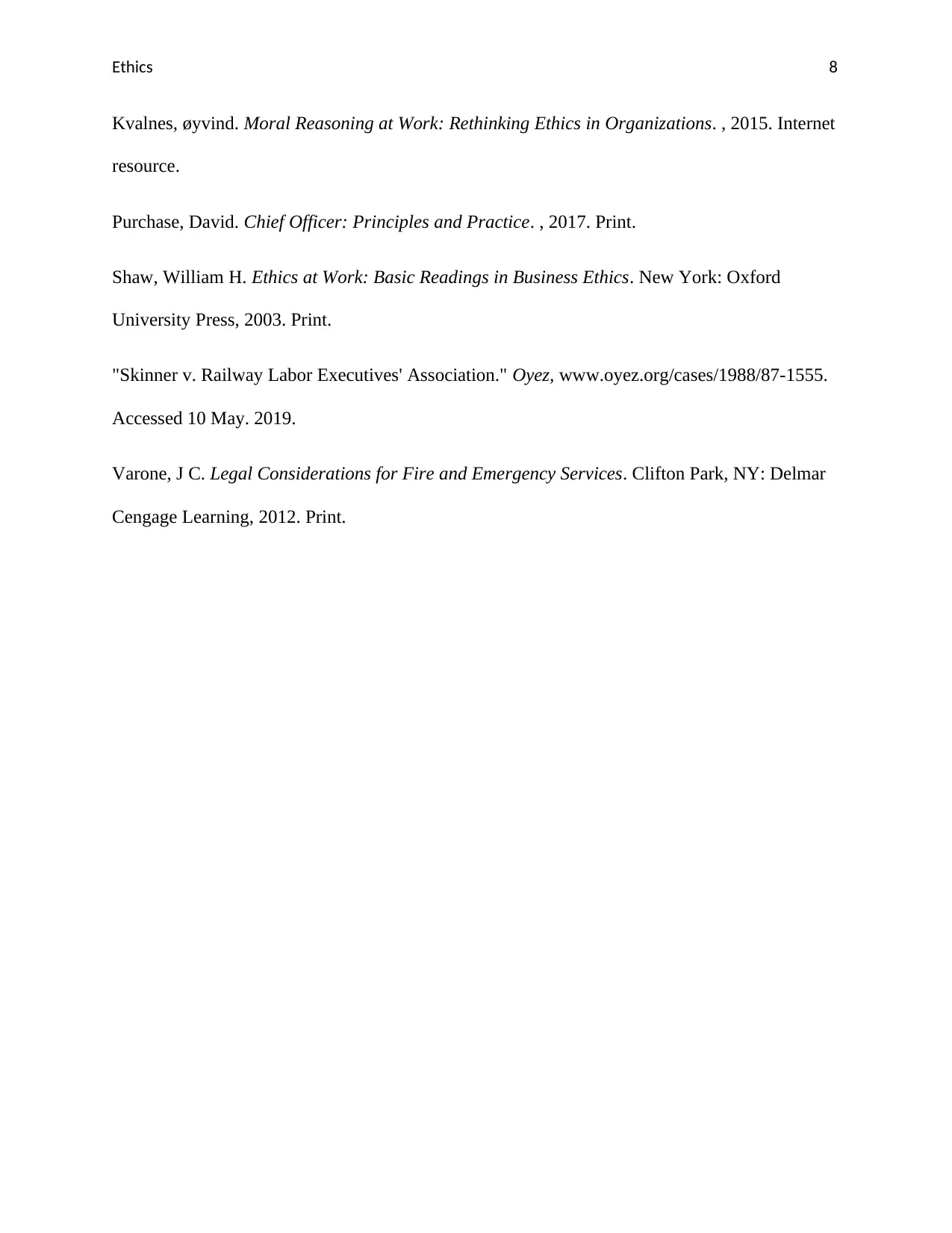
Ethics 8
Kvalnes, øyvind. Moral Reasoning at Work: Rethinking Ethics in Organizations. , 2015. Internet
resource.
Purchase, David. Chief Officer: Principles and Practice. , 2017. Print.
Shaw, William H. Ethics at Work: Basic Readings in Business Ethics. New York: Oxford
University Press, 2003. Print.
"Skinner v. Railway Labor Executives' Association." Oyez, www.oyez.org/cases/1988/87-1555.
Accessed 10 May. 2019.
Varone, J C. Legal Considerations for Fire and Emergency Services. Clifton Park, NY: Delmar
Cengage Learning, 2012. Print.
Kvalnes, øyvind. Moral Reasoning at Work: Rethinking Ethics in Organizations. , 2015. Internet
resource.
Purchase, David. Chief Officer: Principles and Practice. , 2017. Print.
Shaw, William H. Ethics at Work: Basic Readings in Business Ethics. New York: Oxford
University Press, 2003. Print.
"Skinner v. Railway Labor Executives' Association." Oyez, www.oyez.org/cases/1988/87-1555.
Accessed 10 May. 2019.
Varone, J C. Legal Considerations for Fire and Emergency Services. Clifton Park, NY: Delmar
Cengage Learning, 2012. Print.
1 out of 8
Your All-in-One AI-Powered Toolkit for Academic Success.
+13062052269
info@desklib.com
Available 24*7 on WhatsApp / Email
![[object Object]](/_next/static/media/star-bottom.7253800d.svg)
Unlock your academic potential
Copyright © 2020–2025 A2Z Services. All Rights Reserved. Developed and managed by ZUCOL.

